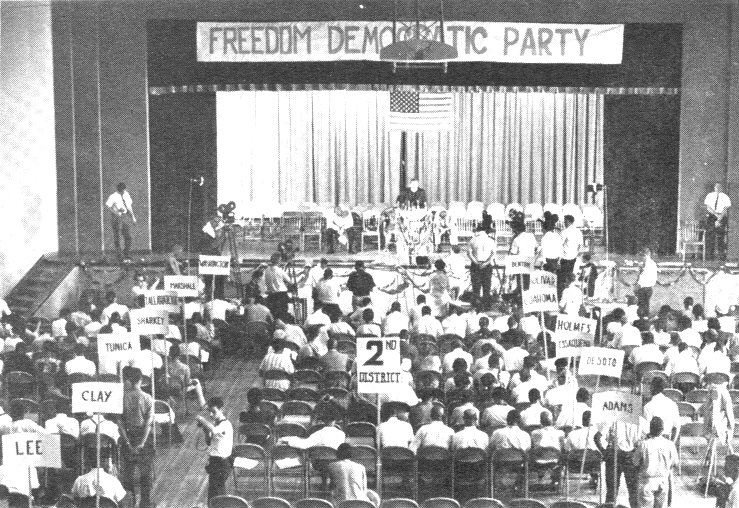Sharecroppers Challenge U.S. Apartheid
The Missississippi Freedom Democratic Party
Lesson by Sara Evers, Julian Hipkins III, Deborah Menkart, and Jenice L. View
This lesson explores one of the most important events in the fight for true democracy in the U.S., when a coalition of grassroots activists challenged the Mississippi political system, the federal government, and the national Democratic Party to abide by the U.S. Constitution. Working within the political “rules,” the activists formed the Mississippi Freedom Democratic Party (MFDP or FDP) in 1964 and mounted a legitimate challenge to the existing system of race-based exclusion. In the process, they garnered a national audience and sparked moral and ethical debates.
MFDP convention in Jackson, Mississippi. Click for larger version.
As historian John Dittmer explains in Local People: The Struggle for Civil Rights in Mississippi:
The Freedom Democratic Party was one of the most important and distinctive institutions to emerge from the Civil Rights Movement. It challenged white supremacy in the most repressive state in the South, combining grassroots activism with a radical social agenda.
Mrs. Fannie Lou Hamer speaks before the Credentials Committee of the Democratic National Convention in Atlantic City, 8/22/1964; AP.
MFDP had its origins in the fall of 1963, when the Council of Federated Organizations (COFO) conducted a “Freedom Vote” to dramatize the exclusion of African Americans from the political process in Mississippi. More than 80,000 Blacks voted Black NAACP state president Aaron Henry for governor and white Tougaloo College chaplain Ed King for lieutenant governor in this mock election. The election's success led to the creation of an independent, Black-led, state Democratic Party that would challenge the legitimacy of the state's white supremacist delegation at the Democratic National Convention in Atlantic City, N.J., in the summer of 1964.
The events surrounding the MFDP’s efforts to be seated at the Democratic National Convention of 1964 in Atlantic City provide a strong example of the unprecedented and sophisticated organizing techniques used to challenge the state sponsored terrorism that blocked political participation by African Americans. In this lesson, students step into the shoes of key people at the Democratic Convention in a dramatic role play based on the real challenges and decisions facing the MFDP delegates.
It is our hope that after this introduction to the MFDP, students will want to learn more about the people and the strategies used to challenge the political establishment in their fight for voting rights in the United States.
Grade Level: 7th Grade+
Time Required: 2-3 Class Periods
Enduring Understandings
Compromise does not always equal justice.
When voting rights are denied to anyone, everyone lacks democracy.
The MFDP was not fighting for integration into the existing structure, but instead for a new political party that was truly equitable and democratic.
The MFDP demonstrated the possibility of true democracy and full citizenship with everyone having an equal voice regardless of literacy levels, gender, class, race, and connections.
Essential Questions
What would it take for there to be legitimate democracy in the United States?
Why did Mississippians, in the face of state sponsored terrorism, take the leadership in challenging the national political party structure?
Overview
This lesson has four sections:
Section I: Student preparation
Students are introduced to the lesson with a warm-up and background reading/viewing on the general process for delegate selection and the MFDP in particular.
Section II: Stepping Into the Atlantic City Convention
Students assume the roles of people who were in Atlantic City or closely connected such as Pres. Lyndon B. Johnson, at the White House, or MFDP chair Lawrence Guyot, who was detained in Mississippi. Following instructions on their role sheet, they ask each other questions and find information. Their main topic of discussion is the initial offer to compromise from Congresswoman Edith Green. The class then regroups to see a video clip of the testimony of Mrs. Hamer in which the MFDP was asking to be seated as the delegation representing all Mississippi Democrats.
Section III: “The Compromise”
Students learn that the Hamer testimony increased optimism for the successful seating of the MFDP at the Convention. But then they learn how LBJ, fearing he would lose the southern vote for his election, planned to defeat the MFDP. (He received information, provided by undercover FBI agents, that helped him pressure key MFDP supporters.) Students are then faced with a new, token compromise. They have to decide whether or not to accept what’s called a “compromise.”
Section IV: What Really Happened?
Students compare the actual decision of the MFDP with their own deliberations and decisions. They also discuss the impact of the MFDP on politics in Mississippi and nationally — and the lessons it provides for the ongoing voting rights struggles today.
Materials
Prereadings on the MFDP
COFO Brochure on the MFDP
Name tag for each student. Use sticky nametags and have them write their (role-play) name. Or download MFDP nametags with photos and use 3 x 4 nametag holders.
Role sheet, one per student (see description of groups in Section III).
Video Clips
Fannie Lou Hamer speech at 1964 Democratic National Convention from Freedom Summer
This lesson was developed by Teaching for Change as part of the Civil Rights Movement and Labor History Initiative in McComb, Miss. The lesson was written by Deborah Menkart, Sara Evers, Julian Hipkins III, and Jenice View, with research, editing, and/or input from Lisa Anderson Todd, Rachel Reinhard, Emilye Crosby, Sarah Slichter, Elizabeth Boyd, Greg Adler, and Falana McDaniel.


